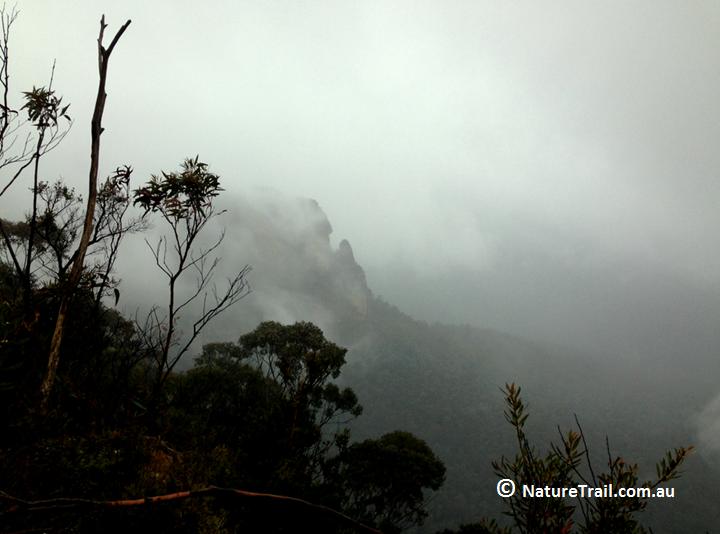A cloud soaked Grose Gorge delivers a surprise of wildflowers

Keen on an early start especially in the damp mist, determination paid off for us. Our small group of three drove out to one of the more remote parts of the Grose Gorge.
Crawling along in the fog, our driver slowly rounded the corner to Eastern Grey Kangaroos happily grazing wild by the track. The dark grey male must have been six foot and right beside the car, so we carefully edged forward passed them.
 “Wildlife by chance indeed”, said Phillip quoting a Nature Trail slogan.
“Wildlife by chance indeed”, said Phillip quoting a Nature Trail slogan.
Our morning’s quest was to track to Pulpit Rock through the escarpment heathland, up and down dale, and to sight the majestic Horseshoe Falls en route.
Importantly, to achieve this at a fair relaxed pace, taking in the wild beauty of the place and enjoying the walk and space.
Fortunately after an overnight welcomed drench, the rain held off, and kitted up comfortably, we headed off exploring this Blue Mountains classic cliff track to the famed Pulpit Rock.
Save for the odd keen trekkers, we felt we had the Gorge to ourselves.
Through the mountain cloud we caught glimpses of incredible Horseshoe Falls and far below the vast lush jungle canopy of the Grose Gorge. It was so wild with the surging cloud as to be comparable to Papua New Guinean highlands.
So sublime.  October is Spring and with the recent warm days following by overnight soaking rain, the native vegetation was visibly sprouting new growth.
October is Spring and with the recent warm days following by overnight soaking rain, the native vegetation was visibly sprouting new growth.
Overnight rain droplets clung to everything all day due to a persistently low dew point.
 We observing the native vegetation changing as we climb high heathland, then descended into steep watercourse glens.
We observing the native vegetation changing as we climb high heathland, then descended into steep watercourse glens.
We soon reached Govetts Leap Brook. It’s pure water once a supply for steam trains through the village of Blackheath from the 1860s.
 The brook flows flows from the overnight rain.
The brook flows flows from the overnight rain.
 Amazingly to one side – a magical ‘infinity pool’, it’s mirrored brook edge sheering right angles to the deep abyss in the mist. This is ‘Govetts Leap’ and it’s associated local legend.
Amazingly to one side – a magical ‘infinity pool’, it’s mirrored brook edge sheering right angles to the deep abyss in the mist. This is ‘Govetts Leap’ and it’s associated local legend.
Govetts Leap is a classic icon of the Blue Mountains, yet most manage to view it from afar as Bridal Veil Falls from the urban comfort of the Govetts Leap car park.
Yet here, our small party is right atop the sublime ‘infinity’.
 This upland swamp, ecologically interconnected to hanging swamps upstream, provides critical habitat for the Blue Mountains endangered Giant Dragonfly. Blue Mountains local Dr Ian Baird knows them well – he did his PhD on them.
This upland swamp, ecologically interconnected to hanging swamps upstream, provides critical habitat for the Blue Mountains endangered Giant Dragonfly. Blue Mountains local Dr Ian Baird knows them well – he did his PhD on them.
On track and keeping behind the fence, we press on.
After a timely morning tea and proper amenities, we continue to a lesser travelled walk route. The remote track, steep and tricky in sections, we all took it easy and our guide was there to advise and assist.

Through a fun wild patch, and then crossing a wild creek…
 Then something very special and completely unexpected enthralled us, even our local guide.
Then something very special and completely unexpected enthralled us, even our local guide.
Heathland wildflowers; wildflowers in abundance everywhere along our track!
Locals term these Broad-leaved Drumsticks. Against the olive green bush vegetation they are strikingly conspicuous with their clusters of globular yellow flower heads. Their scientific name is Isopogon anemonifolius.
 And the Blue Mountain Devil in spring red flower.
And the Blue Mountain Devil in spring red flower.
 The later seed defines it’s name.
The later seed defines it’s name.
The Large Wedge Pea was prolific like a golden corridor lining our remote track.
 Then our remote path opened up into a glorious corridor fairyland of a blooming kaleidoscope of wildflowers – vivid in colours of yellows, pinks, purples, reds, blues…
Then our remote path opened up into a glorious corridor fairyland of a blooming kaleidoscope of wildflowers – vivid in colours of yellows, pinks, purples, reds, blues…
‘Bacon and Eggs‘ native peas envelope us. This is Nature’s garden in spring bloom, and so unexpected and rewarding.
 Phillip happens by a Waratah. How timely we walk through here in spring?
Phillip happens by a Waratah. How timely we walk through here in spring? 
Our guide suggested that the 2006 wildfire that had ripped through the area, was probably the ecological catalyst for the subsequent regrowth of these floral species. He confirmed this by pointing out to us the many burnt out tree stumps.
Most unusually, on a rock right beside our track Helen happens across a local Red Triangle Slug – Australia’s largest. It’s distinctive red triangle on its back contains its breathing pore – resembling the coloured blend of stuffed olives.
Best leave it be.
 Phillip said he discovered its cousin ten metres further on.
Phillip said he discovered its cousin ten metres further on.
After three hours of oxygenated walking, we rose to a lookout to glimpse our quest through the cloud. It was Pulpit Rock beyond the ridge.
And before we know it, our happy group reaches the pulpit reward itself. Our vehicle awaits. Time for a hearty lunch at one of the many eateries in nearby Blackheath.
Our vehicle awaits. Time for a hearty lunch at one of the many eateries in nearby Blackheath.
Watch out for those kangaroos.



